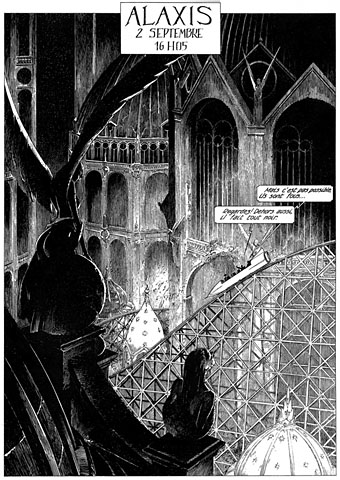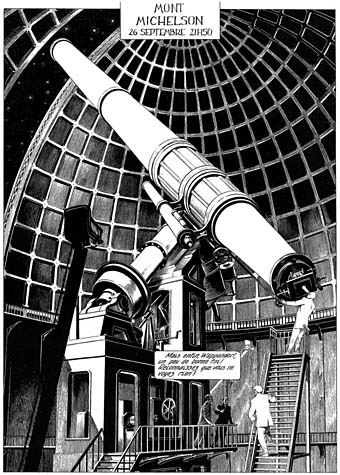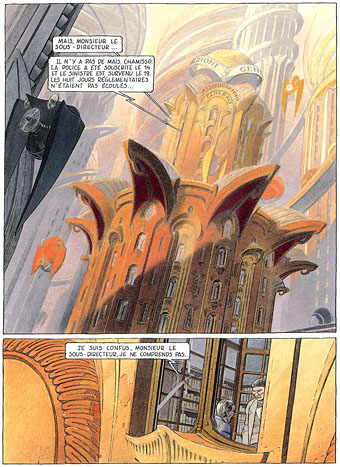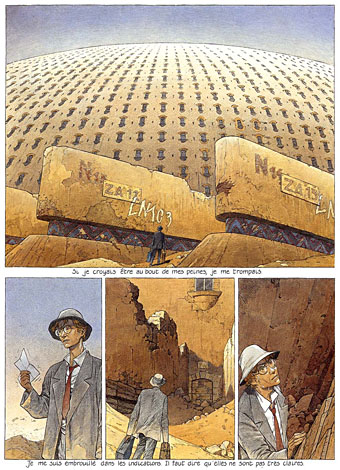
L’enfant penchée.
We’re at the penultimate post in this week-long tribute to the Cités Obscures series of François Schuiten and Benoît Peeters, and there isn’t enough space left to cover some of the more recent volumes in detail. What follows is a quick skate through three more major works.

L’enfant penchée.
L’enfant penchée (1996), or The Leaning Child, is an expanded version of a 1995 children’s story by Schuiten and Peeters, Mary la penchée. Mary is the young daughter of wealthy industrialists from Mylos struck down one day by some cosmic calamity which shifts her centre of gravity, causing her to permanently lean at an apparently impossible angle. When she’s bullied at school she runs away and joins a circus. A meeting with scientists and astronomers leads to a resolving of her affliction, and the repairing of her ruined life. This is a fascinating story for a number of reasons, not least the existence of a parallel narrative taking place in our world which is conveyed using photographs, and which unveils some of the metaphysical aspects of the Obscure World. The story of Mary is also flawlessly drawn. Schuiten uses a black-and-white style modelled on the work of old magazine illustrators like Franklin Booth, and there are further references to Winsor McCay and Jules Verne.

L’ombre d’un homme.
L’ombre d’un homme (1999) or The Shadow of a Man is a story of another ruined life, the tale this time concerning one Albert Chamisso, an insurance agent in the city of Blossfeldtstad. A spate of nightmares forces Chamisso to try an experimental medical treatment which leads to his shadow losing its shade to become more like a coloured reflection. As with Mary in L’enfant penchée, deviation from mundane life leads to social ostracism: Chamisso loses his wife and his job, and moves to an old house on the edge of the city. The similarities with L’enfant penchée are reinforced by brief appearances from a Professor Wappendorf—a major character in the previous story as well as in Brüsel—and some of the people from Mary’s circus. Schuiten and Peeters show that fantastic cities still need human stories to make their invention worthwhile, however fine the architecture. In the case of Blossfeldtstad, Schuiten gives us a city whose buildings—in the “Vegetalistic Style”—are beautiful Art Nouveau skyscrapers based on the famous plant photographs of Karl Blossfeldt. There are no airships in this metropolis, instead winged flying machines fill the skies.

La frontière invisible
La frontière invisible (2002, 2004) is a two-book story about a young cartographer who goes to work at the enormous dome of the Centre for Cartography in the Somonites desert. One of the women working there has a birthmark on her body which turns out to match a map of crucial geo-political import. When the Centre is invaded by an army, the pair go on the run. This is a less stimulating story than some of the earlier works, with writer and artist giving us another hermetic community of scholars. It does, however, give Schuiten an opportunity to concentrate on landscapes rather than architecture. There are also more unusual modes of transport, including two-person monorail bicycles which the map-makers use to travel around their vast workplace.
One last post about the Obscure World tomorrow.
Elsewhere on { feuilleton }
• The fantastic art archive
Previously on { feuilleton }
• Brüsel by Schuiten & Peeters
• La route d’Armilia by Schuiten & Peeters
• La Tour by Schuiten & Peeters
• La fièvre d’Urbicande by Schuiten & Peeters
• Les Murailles de Samaris by Schuiten & Peeters
• The art of François Schuiten
• Karl Blossfeldt
• Taxandria, or Raoul Servais meets Paul Delvaux

One thought on “Further tales from the Obscure World”
Comments are closed.